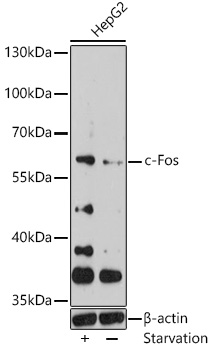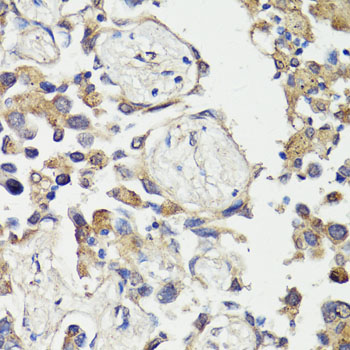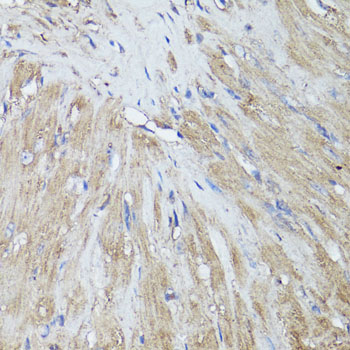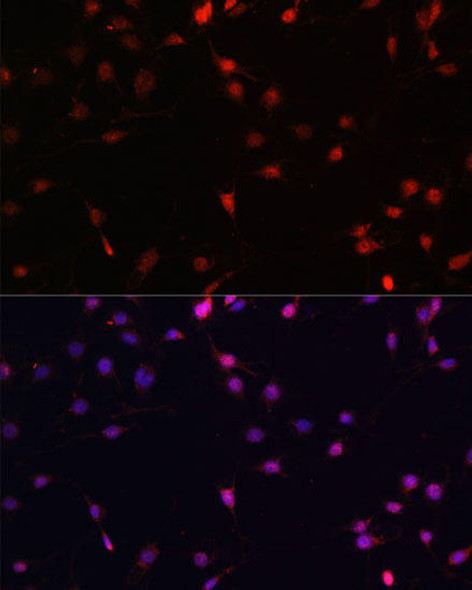Cell Biology Antibodies 1
Anti-c-Fos Antibody (CAB0236)
- SKU:
- CAB0236
- Product Type:
- Antibody
- Reactivity:
- Human
- Reactivity:
- Mouse
- Reactivity:
- Rat
- Host Species:
- Rabbit
- Isotype:
- IgG
- Antibody Type:
- Polyclonal Antibody
- Research Area:
- Cell Biology
Description
| Antibody Name: | Anti-c-Fos Antibody |
| Antibody SKU: | CAB0236 |
| Antibody Size: | 20uL, 50uL, 100uL |
| Application: | WB IHC IF |
| Reactivity: | Human, Mouse, Rat |
| Host Species: | Rabbit |
| Immunogen: | Recombinant fusion protein containing a sequence corresponding to amino acids 211-380 of human c-Fos (NP_005243.1). |
| Application: | WB IHC IF |
| Recommended Dilution: | WB 1:500 - 1:2000 IHC 1:50 - 1:200 IF 1:50 - 1:200 |
| Reactivity: | Human, Mouse, Rat |
| Positive Samples: | HepG2 |
| Immunogen: | Recombinant fusion protein containing a sequence corresponding to amino acids 211-380 of human c-Fos (NP_005243.1). |
| Purification Method: | Affinity purification |
| Storage Buffer: | Store at -20'C. Avoid freeze / thaw cycles. Buffer: PBS with 0.02% sodium azide, 50% glycerol, pH7.3. |
| Isotype: | IgG |
| Sequence: | GFPE EMSV ASLD LTGG LPEV ATPE SEEA FTLP LLND PEPK PSVE PVKS ISSM ELKT EPFD DFLF PASS RPSG SETA RSVP DMDL SGSF YAAD WEPL HSGS LGMG PMAT ELEP LCTP VVTC TPSC TAYT SSFV FTYP EADS FPSC AAAH RKGS SSNE PSSD SLSS PTLL AL |
| Gene ID: | 2353 |
| Uniprot: | P01100 |
| Cellular Location: | Cytoplasm, Endoplasmic reticulum, Nucleus, cytosol |
| Calculated MW: | 28kDa/36kDa/40kDa |
| Observed MW: | 62kDa |
| Synonyms: | FOS, AP-1, C-FOS, p55, c-Fos |
| Background: | The Fos gene family consists of 4 members: FOS, FOSB, FOSL1, and FOSL2. These genes encode leucine zipper proteins that can dimerize with proteins of the JUN family, thereby forming the transcription factor complex AP-1. As such, the FOS proteins have been implicated as regulators of cell proliferation, differentiation, and transformation. In some cases, expression of the FOS gene has also been associated with apoptotic cell death. |
| UniProt Protein Function: | Fos: a proto-oncogenic transcription factor of the bZIP family. Dimerizes with proteins of the JUN family, thereby forming the transcription factor complex AP-1. FOS proteins function as regulators of cell proliferation, differentiation, and transformation. In some cases, expression of FOS has also been associated with apoptotic cell death. Expression increases upon a variety of stimuli, including growth factors, cytokines, neurotransmitters, polypeptide hormones, stress and cell injury. |
| UniProt Protein Details: | Protein type:Motility/polarity/chemotaxis; DNA-binding; Transcription factor; Oncoprotein Chromosomal Location of Human Ortholog: 14q24.3 Cellular Component: nucleoplasm; transcription factor complex; neuron projection; membrane; endoplasmic reticulum; nucleus; cytosol Molecular Function:protein binding; double-stranded DNA binding; transcription factor activity; transcription factor binding Biological Process: transcription from RNA polymerase II promoter; response to gravity; response to cAMP; positive regulation of osteoclast differentiation; positive regulation of transcription, DNA-dependent; response to toxin; stress-activated MAPK cascade; response to lipopolysaccharide; toll-like receptor 3 signaling pathway; female pregnancy; toll-like receptor 10 signaling pathway; toll-like receptor 5 signaling pathway; regulation of transcription factor activity; transforming growth factor beta receptor signaling pathway; conditioned taste aversion; DNA methylation; inflammatory response; toll-like receptor 4 signaling pathway; aging; response to corticosterone stimulus; response to drug; response to light stimulus; nervous system development; MyD88-independent toll-like receptor signaling pathway; sleep; toll-like receptor 2 signaling pathway; cellular response to hormone stimulus; regulation of transcription from RNA polymerase II promoter; MyD88-dependent toll-like receptor signaling pathway; response to mechanical stimulus; response to cytokine stimulus; cellular response to extracellular stimulus; toll-like receptor signaling pathway; innate immune response; positive regulation of transcription from RNA polymerase II promoter; response to cold; toll-like receptor 9 signaling pathway; response to progesterone stimulus |
| NCBI Summary: | The Fos gene family consists of 4 members: FOS, FOSB, FOSL1, and FOSL2. These genes encode leucine zipper proteins that can dimerize with proteins of the JUN family, thereby forming the transcription factor complex AP-1. As such, the FOS proteins have been implicated as regulators of cell proliferation, differentiation, and transformation. In some cases, expression of the FOS gene has also been associated with apoptotic cell death. [provided by RefSeq, Jul 2008] |
| UniProt Code: | P01100 |
| NCBI GenInfo Identifier: | 120470 |
| NCBI Gene ID: | 2353 |
| NCBI Accession: | P01100.1 |
| UniProt Secondary Accession: | P01100,P18849, A8K4E2, B4DQ65, |
| UniProt Related Accession: | P01100 |
| Molecular Weight: | 380 |
| NCBI Full Name: | Proto-oncogene c-Fos |
| NCBI Synonym Full Names: | FBJ murine osteosarcoma viral oncogene homolog |
| NCBI Official Symbol: | FOS |
| NCBI Official Synonym Symbols: | p55; AP-1; C-FOS |
| NCBI Protein Information: | proto-oncogene c-Fos; activator protein 1; cellular oncogene c-fos; G0/G1 switch regulatory protein 7; FBJ murine osteosarcoma viral (v-fos) oncogene homolog (oncogene FOS) |
| UniProt Protein Name: | Proto-oncogene c-Fos |
| UniProt Synonym Protein Names: | Cellular oncogene fos; G0/G1 switch regulatory protein 7 |
| Protein Family: | Fos-related antigen |
| UniProt Gene Name: | FOS |
| UniProt Entry Name: | FOS_HUMAN |









